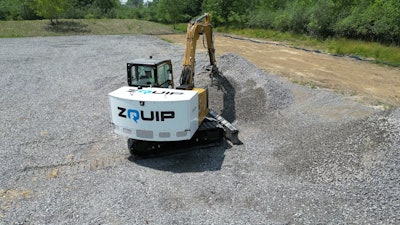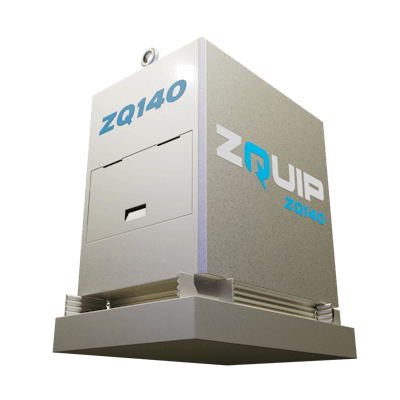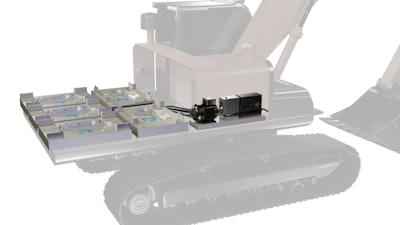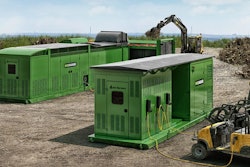
Looking at what multiple heavy equipment manufacturers are doing with electrification, Moog Construction decided to start from scratch. From a research perspective, the approach was more to determine what is necessary for electrification to happen and what would it look like.
Nominated for an Intermat Innovation Award, the ZQuip energy kit, which converts diesel-powered construction fleets into zero-emissions machines, was first demonstrated with the conversion of a Caterpillar 308 excavator.
The ZQuip battery modules are standalone energy units. They can exist three ways on a jobsite: on a machine; off the machine on a charger; or off the machine as a genset.

Spending a lot of time on jobsites and with contractors and other groups, LaFleur said they were not trying to determine what the industry needs, but rather why the industry won’t invest in electric vehicles. The analysis showed that there were many more issues than simply placing a zero-emission machine on a diesel jobsite.
Instead of approaching it strictly from the vantage point of the machines, LaFleur said the ZQuip engineers looked at it more holistically.
“Everything that we've been doing is around this overarching view that in order for zero emission to work, it's got to work at a site level and at a fleet level,” he said. “In order for people to adopt it's got to be productive. and it's got to make sense for their operations.”
LaFleur said, ZQuip has developed a possible solution, rather than guessing what the outcome may be and sorting out the best- and worst-case scenarios.
“Our pitch is, we’re not selling you an electric machine, we are basically selling you a bare tool,” he said. “It’s like if you buy your Milwaukee Tool drill with no battery, and then we're selling you the batteries and then the batteries have multiple applications.”
The ZQuip battery modules come in 70- and 140-kWh swappable sizes. Generally, the 70 kWh modules will operate compact track loaders or compact wheel loaders or excavators, while the 140 kWh batteries will be utilized on the larger excavators and other machines.
LaFleur noted that the 70 kWh modules can be mixed with the 140 kWh but generally not vice versa based on the size of the machines.
“We liked the idea of there being just one universal module and then it goes back to our other our vision of this whole mixed fleet, and there's all class sizes of machines that just don't have to exist on a site,” he said.
Further, the batteries within the ZQuip modules will evolve as battery systems improve while not compromising the modules from being swappable. Comparatively, he said if a contractor buys a machine with integrated batteries, they are owning the risk of whether those same are batteries are still in use in a few years.
“With these modules, we see it as allowing customers to always get the newest technology for their machines because we've separated the energy from the machine,” LaFleur said. “The machine is always able to receive ZQuip modules because the ZQuip modules can continue to evolve and improve without you having to buy a new capital asset.”
Unlike OEMs who are looking to sell customers a new machine, ZQuip is aiming to set the standard of how the concept of modularity among electric machines works.
“People aren't coming to us because they prefer our solution over Caterpillar, they're coming to us, because it doesn't exist yet” he said. “This question of what the limitations are and how does this fit into the OEMs in the future is a good one. All I know is, right now, we have an opportunity to provide the best zero emission solution and jobsite to customers.”
To date, within the construction EV market, there is no clear leader, because everyone is always trying something new. LaFleur knows that it will take a lot of people and multiple companies to ultimately make the idea of electrification work.
Over the past few years, Moog has already been active on a variety of projects either independently or working collaboratively with companies including Doosan Bobcat and Komatsu and electrification and automation solutions.
LaFleur admits that as Moog first entered the construction space, the response was “Who are you guys? You don’t do construction.”
“Nobody is going to be the captain in the market for this,” he said. “Our system is new and different, and it is going to be a part of it. I'm hopeful that it's something that will resonate with people.”
The idea of the modularity is to make sure customers have the option and capability to jobs completed. According to LaFleur, any one machine only needs one ZQuip module to operate. To compensate for those times when a machine may need extra power for using a particular attachment or completing a particular task, multiple modules are designed to run in parallel, rather than in serial which drains one before moving onto the next one.
“It's just another level of just trying to think through these use cases, and what are the ways that we can try to develop this and see if it's something truly needed,” he said.
Rather than coming to a jobsite with a 25-ton Cat excavator, a compact track loader and a wheel loader, he suggests taking a step back and analyzing what the machines are doing and what the total energy needs for the jobsite is.
“From there, you connect the dots between this is the work I have to get done and these are the machines I have available to do it and then we try to get the power to those machines,” LaFleur said.
For example, during the development of ZQuip, the Moog engineers noticed that using a 25-ton excavator with 800 kWh on it that isn’t doing a lot of work on a particular day is just a waste of energy.
“We approached this with the modularity of understanding the jobs to be done, understand how that fits into your con ops and then our software will overlay that, to just help plan things for you, in terms of which machines need how much power at a certain time,” he said.
The ZQuip software is designed to see what the state of charge is on every machine being utilized and show the rundown rate based on the application. With electrification, many contractors take the view of bigger (more power) is better.
ZQuip is attempting to challenge that notion.
“There are so many things like that, where it's not a wrong assumption or a wrong point of view, it's just an antiquated one that doesn't work anymore,” LaFleur said. “I think that this is the most fascinating part of the zero-emission shift is the behavioral changes that can happen from this.”
Visiting various jobsites, ZQuip engineers heard many contractors discuss the need for X-amount of power. Often, they did not really need the power they were suggesting.
“There is a balance between what people say they want and what they really need,” he said. “We can accurately decide what kind of power and energy needs you have and if something is off, we can warn you and tell you.”
The difference from some existing electrified equipment is that these machines with the ZQuip modules are smart computers.
“It's a whole different world,” LaFleur said. “This is not a dumb diesel machine or even a smart diesel machine. This is a supercomputer out there that is going to make sure that you are going to run it the right way.”
LaFleur believes it will be those who can understand what needs to change outside of the machine, and understand how operations, finance, and planning all must change, who will ultimately have the advantage in adoption of electrification.With ZQuip’s modularity, he said the machine is essentially an attachment to the battery.
According to LaFleur, the value of ZQuip’s solution is in the idea that people will not adopt electrification without the option of having a mixed fleet. Under current concepts of electric machines, mixed fleets are more difficult due to the varied charging solutions that currently are not standardized.
“If we can show that having this standardization and this way of making a fleet work, that's where the value really comes in,” he said. “We are not selling individual excavators, loaders, or other machines,” emphasized LaFleur. “The innovation with ZQuip is this: To enable customers to have a zero-emissions work site, we are creating fleets of zero-emissions machines that make the most sense from the perspective of productivity and cost.”
 Those interested in a conversion using ZQuip need only provide the size, make and year of the machines they wish to convert.ZQuip
Those interested in a conversion using ZQuip need only provide the size, make and year of the machines they wish to convert.ZQuip
From diesel to electric
For the conversion process, Moog has a portfolio of machines that they know how to convert and are always looking to build out that portfolio, because once the specs are available, the conversion is easier.
“You don’t want to make a high-tech improvement on a 10-year-old machine,” LaFleur noted. “There are a lot of electronic differences, and the newer machines are smarter and easier to update.”
Those interested need only provide the size, make and year of the machines they wish to convert. With that information, ZQuip sizes up the machine and specs out the inside to ensure access to the motor, determines what the conversion would look like and how much power would be available based on what the customer is looking for in what applications.
For a lot of heavy equipment, the limitation on electrification has partially been about size. For ZQuip LaFleur said the limitation is not on the battery modules, it is on the availability of electric motors to match the torque and power needed.
 The ZQuip battery modules come in 70- and 140 kWh swappable sizes.ZQuip
The ZQuip battery modules come in 70- and 140 kWh swappable sizes.ZQuip
In terms of size, ZQuip ensures the counterweight and center of gravity remains the same, so if there are three ZQuip modules, there are two ballast modules. Weight distribution is in the ballast, which provides ZQuip more flexibility.
“It’s always keeping things stable and centered,” LaFleur said. “We're not trying to win people over on the machine, we're trying to win people over on the site and fleet management process. I want people to get into this and say, wow, this feels just like the diesel.”
Typically, ZQuip will do the conversion on the customer’s machine, although dealers’ have approached them to convert the machine to sell to a customer.
Sales of the actual battery modules are independent of the conversion process. Once the conversion is worked through, ZQuip recommends a minimum number of battery modules, based on the anticipated power needs for a given customer. The company will work with customers to come up with a balanced concept of their energy needs based on typical workload.
As the conversions are being ordered, LaFleur said they get several questions about temperature management and functionality. The ZQuip modules are AI-thermally managed.
“We can also set them so they know what time you're starting in the morning, and we can make sure that the batteries can run up a little warmer in the afternoon and so that they coast down so that when you start, they're at the right temperature ready to go,” he said. The way the modules are insulated the battery management system is designed to keep the temperatures at the levels needed.
 Artist's rendering of construction machines outfitted with ZQuip modules.ZQuip
Artist's rendering of construction machines outfitted with ZQuip modules.ZQuip













